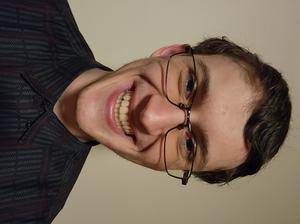Splash Biography
WYATT KREMER, Yale Senior | Physics and Egyptology
|
Major: Physics, NELC College/Employer: Yale Year of Graduation: 2025 |

|
Brief Biographical Sketch:
Wyatt Kremer is a senior at Yale University pursuing a double major in Intensive Physics and Near Eastern Languages and Civilizations with an Advanced Language Certificate in ancient Egyptian. This is his fourth course through Splash at Yale. He is excited to share how modern particle physics has found its way into the study of ancient Egypt. Wyatt has broad interests in theoretical physics and Egyptian philology. Additionally, he loves collecting rocks and minerals as well as hiking. Wyatt was born and raised in Minden, Nevada. Past Classes(Clicking a class title will bring you to the course's section of the corresponding course catalog)E4938: Physics and Ancient Egypt: The Muographic Detection of a Big Void within Khufu's Pyramid in Sprout Fall 2024 (Oct. 05 - 12, 2024)
In November 2017, it was announced that a large void had been discovered above the Grand Gallery of king Khufu's pyramid at Giza. This was surprisingly done without scientists ever having gone inside to see the empty space. In fact, we still do not know if this big void is really a bunch of smaller voids connected together or if the whole thing is flat or sloped. So how did the scientists know it was there?
The trick is that although the cavity may be inaccessible to us, it is not to a flavor of subatomic particles called muons. Muons are similar to electrons but have a greater mass. This allows them to penetrate deep within the stone. Measuring how many muons go into the pyramid (from cosmic rays constantly bombarding Earth) and then leave on the other side gives information about what is in between. We will talk about how this works and how our knowledge of modern particle physics revealed the location and size of the big void within Khufu's pyramid.
S4698: The Illusions of Light in Splash Spring 2023 (Apr. 01, 2023)
Despite being all around us, light is very mysterious. Physicists have struggled for centuries to say exactly what light even is and have devoted a whole field to studying it called optics. In this class, we are going to take a look at some surprising behaviors arising from light-matter interactions and try to explain why they happen. If illusory experiences are "seeing as it is not", why does physics make them our reality?
M4668: Ancient Egyptian Mathematics in Splash Fall 2022 (Oct. 29, 2022)
Ancient Egyptian math departs from the modern treatment of algebra by emphasizing creativity and intuition. We will learn how to count, add fractions, and apply our understanding to problems considered by scribes in the Rhind Papyrus. The main goal of this course is to enjoy the beauty of the Egyptian approach to elementary arithmetic.
M4521: Ancient Egyptian Mathematics in Splash Spring 2022 (Apr. 16, 2022)
Ancient Egyptian math departs from the modern treatment of algebra by emphasizing creativity and intuition. We will learn how to count, add fractions, and apply our understanding to problems considered by scribes in the Rhind Papyrus. The main goal of this course is to enjoy the beauty of the Egyptian approach to elementary arithmetic.
C4413: Ancient Egyptian Mathematics in Sprout Fall 2021 (Oct. 02 - 16, 2021)
Ancient Egyptian math departs from the modern treatment of algebra by emphasizing creativity and intuition. We will learn how to count, add fractions, and apply our understanding to problems considered by scribes in the Rhind Papyrus. The main goal of this course is to enjoy the beauty of the Egyptian approach to elementary arithmetic.
S4457: Introduction to Lagrangian Mechanics in Splash Fall 2021 (Nov. 13, 2021)
Identifying bodies within a system, drawing free body diagrams, and using F=ma to solve for the resulting motion - are all dynamics problems just an application of Newton's laws? We will explore a powerful formulation of mechanics called Lagrangian formalism and why we would ever prefer to use it. In doing so, we may find that our understanding of solving basic mechanics problems grows more profound.
|
|
